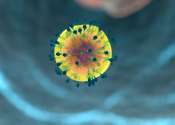T helper cells (also known as effector T cells or Th cells) are a sub-group of lymphocytes (a type of white blood cell or leukocyte) that play an important role in establishing and maximizing the capabilities of the immune system. These cells are unusual in that they have no cytotoxic or phagocytic activity; they cannot kill infected host (also known as somatic) cells or pathogens, and without other immune cells they would usually be considered useless against an infection. Th cells are involved in activating and directing other immune cells, and are particularly important in the immune system. They are essential in determining B cell antibody class switching, in the activation and growth of cytotoxic T cells, and in maximizing bactericidal activity of phagocytes such as macrophages. It is this diversity in function and their role in influencing other cells that gives T helper cells their name.
Mature Th cells are believed to always express the surface protein CD4. T cells expressing CD4 are also known as CD4+ T cells. CD4+ T cells are generally treated as having a pre-defined role as helper T cells within the immune system, although there are known rare exceptions. For example, there are sub-groups of regulatory T cells, natural killer T cells, and cytotoxic T cells that are known to express CD4 (although cytotoxic examples have been observed in extremely low numbers in specific disease states, they are usually considered non-existent). All of the latter CD4+ T cell groups are not considered T helper cells, and are beyond the scope of this article.
The importance of helper T cells can be seen from HIV, a virus that infects cells that are CD4+ (including helper T cells). Towards the end of an HIV infection the number of functional CD4+ T cells falls, which leads to the symptomatic stage of infection known as the acquired immune deficiency syndrome (AIDS). There are also some rare disorders that result in the absence or dysfunction of CD4+ T cells. These disorders produce similar symptoms, and many of these are fatal.








